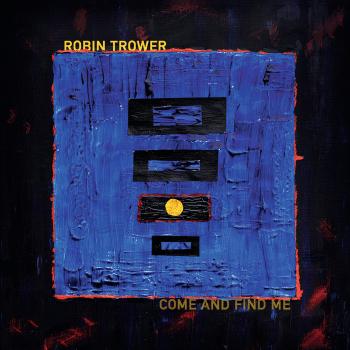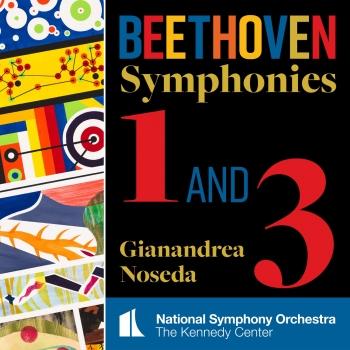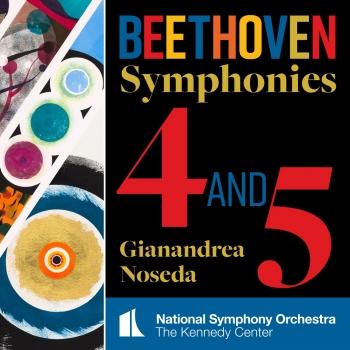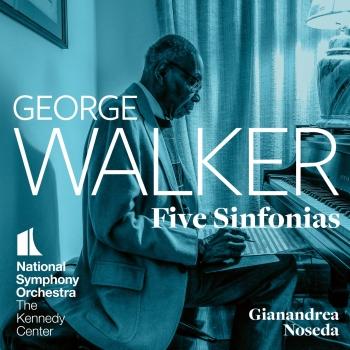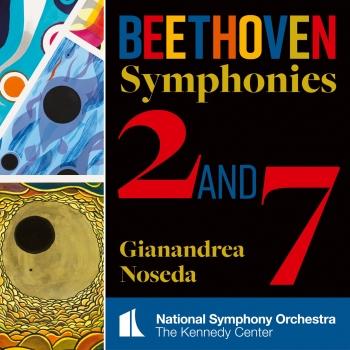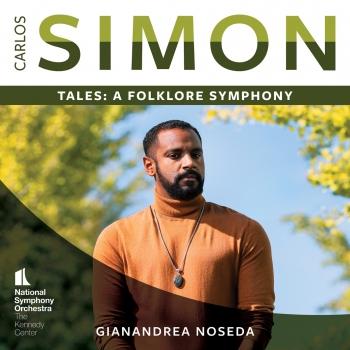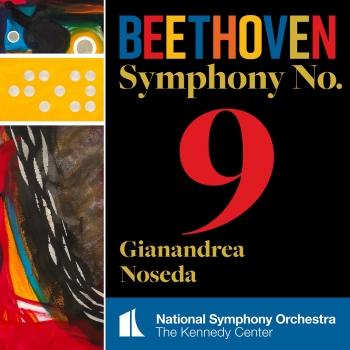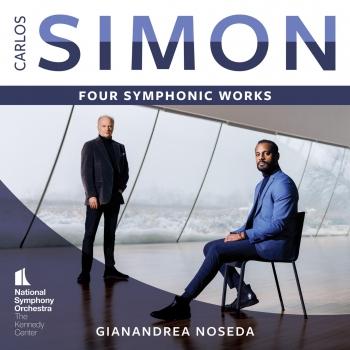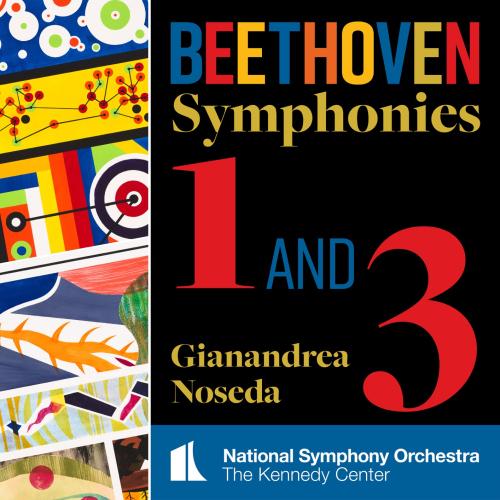
Beethoven: Symphonies Nos 1 & 3 National Symphony Orchestra, Kennedy Center & Gianandrea Noseda
Album Info
Album Veröffentlichung:
2022
HRA-Veröffentlichung:
16.09.2022
Label: National Symphony Orchestra
Genre: Classical
Subgenre: Orchestral
Interpret: National Symphony Orchestra, Kennedy Center & Gianandrea Noseda
Komponist: Ludwig van Beethoven (1770-1827)
Das Album enthält Albumcover Booklet (PDF)
- Ludwig van Beethoven (1770 - 1827): Symphony No. 1 in C Major, Op. 21:
- 1 Beethoven: Symphony No. 1 in C Major, Op. 21: I. Adagio molto - Allegro con brio 09:05
- 2 Beethoven: Symphony No. 1 in C Major, Op. 21: II. Andante cantabile con moto 07:46
- 3 Beethoven: Symphony No. 1 in C Major, Op. 21: III. Menuetto. Allegro molto e vivace 03:58
- 4 Beethoven: Symphony No. 1 in C Major, Op. 21: IV. Finale. Adagio - Allegro molto e vivace 05:47
- Symphony No. 3 in E-Flat Major, Op. 55 "Eroica":
- 5 Beethoven: Symphony No. 3 in E-Flat Major, Op. 55 "Eroica": I. Allegro con brio 16:41
- 6 Beethoven: Symphony No. 3 in E-Flat Major, Op. 55 "Eroica": II. Marcia funebre. Adagio assai 14:21
- 7 Beethoven: Symphony No. 3 in E-Flat Major, Op. 55 "Eroica": III. Scherzo. Allegro vivace 05:19
- 8 Beethoven: Symphony No. 3 in E-Flat Major, Op. 55 "Eroica": IV. Finale. Allegro molto 11:17
Info zu Beethoven: Symphonies Nos 1 & 3
Symphony No 1 in C major Op 21 (1800):
The energy with which the 22-year-old Beethoven threw himself into Viennese music life was truly astounding. As he was leaving his native Bonn for Vienna in 1792, one of his patrons, Count Waldstein, inscribed the following in the young man’s book of souvenirs: 'With the help of assiduous labor you shall receive Mozart’s spirit from Haydn’s hands.' Thus, Waldstein became the first person to mention Haydn, Mozart, and Beethoven in the same breath. The prophecy came true: Beethoven soon became the most talked-about musician in the imperial capital, equally famous as a composer and a pianist, courted by the aristocracy and admired by the public.
Beethoven’s first 20 opus numbers, published between 1795 and 1801, cover just about every current genre of instrumental music: two piano concertos, sonatas for solo piano, for violin and piano, for cello and piano, string trios, piano trios, string quartets, quintets, as well as the Septet in E flat which became the most popular of all his works. One significant type of music was still missing from this list, however, and Beethoven knew he couldn’t fully be an heir of Haydn and Mozart until he had written a symphony....
Symphony No 3 in E flat major 'Eroica' Op 55 (1802-1804):
Beethoven’s third symphony represents a quantum leap within the composer’s oeuvre as it does in the history of music in general. The sheer size of the work—almost twice the length of the average 18th-century symphony—was a novelty, to say nothing of what amounted to a true revolution in musical technique and, even more importantly, in musical expression.
Music had never before expressed the idea of struggle in such a striking way. Beethoven’s encroaching deafness is surely part of the reason why that idea took center stage in the composer’s thinking at the time, and it is fair to assume that his physical affliction was behind the spectacular change that Beethoven’s style underwent in what has come to be called his 'heroic' period. Yet in the case of the third symphony, the personal crisis was compounded by the dramatic political events of the day, and in particular by Beethoven’s ambivalent relationship with the leading political figure of era—Napoleon Bonaparte.
National Symphony Orchestra
Gianandrea Noseda, conductor
Gianandrea Noseda
is one of the world’s most sought-after conductors, equally recognized for his artistry in both the concert hall and opera house. The 2021 – 2022 season marks his fifth as Music Director of the National Symphony Orchestra.
Noseda’s artistic leadership has inspired the NSO and in 2019, he and the National Symphony Orchestra earned rave reviews for their first concerts together at New York’s Carnegie Hall and Lincoln Center. The 2019–2020 season saw their artistic partnership continue to flourish with the launch of a new NSO recording label distributed by LSO Live for which Noseda also records as principal guest conductor of the London Symphony Orchestra. The first recording on the label featured Dvořák’s Symphony No 9 and Copland’s Billy the Kid.
Noseda became General Music Director of the Zurich Opera House in September 2021 and will lead multiple productions each season. The centerpiece of his tenure will be a new production of the Ring Cycle, marking his first performances of Wagner’s tetralogy. From 2007 to 2018, Noseda served as Music Director of the Teatro Regio Torino, where his leadership and his initiatives propelled the company’s global reputation resulting in a golden era for this opera house.
National Symphony Orchestra
Founded in Washington, D.C. in 1931 by Hans Kindler, the National Symphony Orchestra (NSO) has always been committed to artistic excellence and music education. Now, nearly 90 years later, the NSO continues to thrive in this capital city. In 1986, the Orchestra became an artistic affiliate of the John F. Kennedy Center for the Performing Arts, where it has performed a full season of subscription concerts since the Center opened in 1971. In addition, the 98-member NSO regularly participates in events of national and international importance, including official holiday celebrations for Memorial and Independence Days through its regularly televised appearances on PBS on the lawn of the U.S. Capitol for Capital Concerts, live-streamed performances from the Kennedy Center Concert Hall on medici.tv, and local radio broadcasts on Classical WETA 90.9FM, making the NSO one of the most-heard orchestras in the country.
Gianandrea Noseda serves as the National Symphony Orchestra’s seventh music director, joining the NSO’s legacy of such distinguished leaders as Christoph Eschenbach, Leonard Slatkin, Mstislav Rostropovich, Antal Doráti, Howard Mitchell, and Hans Kindler. Its artistic leadership also includes Principal Pops Conductor Steven Reineke and Artistic Advisor Ben Folds.
Since assuming the leadership of the NSO, Gianandrea Noseda has brought a renewed sense of energy and focus to the orchestra, which has resulted in wide-ranging recognition from local, national, and international publications, increases in subscription and single ticket sales, and the expansion of the Orchestra’s reach through livestreamed concerts and recordings. The New York Times called the NSO and Noseda’s recent Carnegie Hall appearance 'spectacular', while the Washington Post wrote that 'there’s a certain flair going on at the National Symphony Orchestra', consistently reinforcing that this artistic partnership continues to gain momentum.
Additionally, the NSO’s community engagement projects are nationally recognized, including NSO In Your Neighborhood, which annually comprises a week of performances in schools, churches, community centers, and other unexpected venues; Notes of Honor, which offers free performances for active, veteran, prior service, and retired members of the military and their families; and Sound Health, a collaboration with the National Institutes of Health (NIH) and its affiliated organizations. Career development opportunities for young musicians include the NSO Youth Fellowship Program and its acclaimed, tuition-free Summer Music Institute.
Booklet für Beethoven: Symphonies Nos 1 & 3



